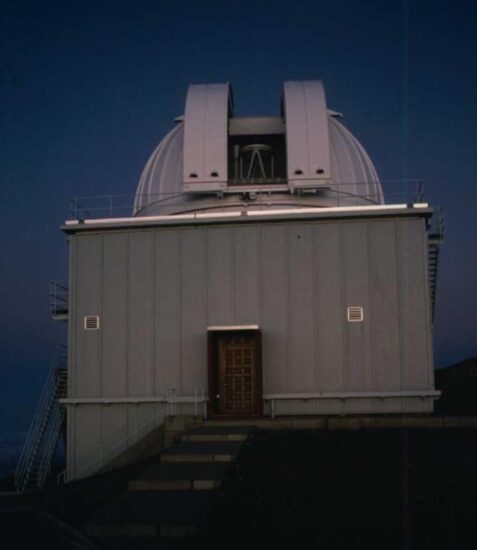NSF to Refurbish La Palma Telescope

Texas A&M University-Commerce faculty and students will increase their ability to make astronomical observations via a newly acquired telescope in the Canary Islands. Starting in January 2015, students may access the remotely operated 1.0-m Jacobus Kapteyn Telescope (JKT) on the Spanish Canary Island of La Palma, off the coast of Morocco. The JKT, situated at an altitude of 2,360 meters at the Observatorio del Roque de los Muchachos, has sat idle since 2003.
In late 2011, the Science and Technology Facilities Council (STFC) of the United Kingdom announced the opportunity for interested parties to submit proposals to take over telescope operations. The astronomers of the Southeastern Association for Research in Astronomy (SARA) which A&M-Commerce joined in 2012, jumped at the chance. “It is a great opportunity for us,” says Matthew A. Wood, Physics & Astronomy Department Head and Professor at A&M-Commerce, “SARA has been remotely operating these types of telescopes for over 20 years and believed we had an excellent chance of convincing the STFC that we were the right people for the job.”
SARA is a consortium of 11 universities of higher education with similar goals for the education of astronomy and astrophysics students. SARA currently operates a 0.9-m telescope at Kitt Peak National Observatory in Arizona and a 0.6-m telescope at Cerro Tololo Inter-American Observatory in Chile.
Since learning of the opportunity, the SARA astronomers have been negotiating for the handover of telescope operations and securing funding from the National Science Foundation (NSF) to acquire the necessary equipment convert the JKT to a remote observatory. In August 2013, Wood and SARA colleague Daniel Batcheldor of the Florida Institute of Technology received notice that the NSF had decided to fund the $474,000 project via its Major Research Instrumentation Program (MRI). Wood notes that “Dr. Batcheldor's role was central to the success of the MRI proposal, and he will serve as the Observatory Director for the new facility.”
Wood continues, “In combination with our other facilities, we will be able to easily determine trigonometric distances to near-Earth asteroids and comets, monitor objects that vary their brightness for up to 21 hours a day, and rapidly make follow-up observations of supernovae, gamma-ray bursts and other transient events.”
The geographical location of the JKT in the Greenwich Mean Time zone not only increases the science capabilities of SARA's network, but provides a much more convenient astronomical teaching facility. It can be a significant challenge to faculty and student researchers to teach or go to class during the day, and then carry out astronomical research projects throughout the night. With the JKT the researchers can start observations at lunchtime in Texas and be done by midnight. “This will give A&M Commerce and other SARA astrophysicists the opportunity to study the variability of astronomical targets over a greatly extended timeline. Combined with our other telescopes, we'll have access of up to 87 percent of the northern sky,” said Kent Montgomery, Planetarium Director and Professor at A&M-Commerce.
Batcheldor will revisit the JKT site this December to finalize plans to install the necessary equipment for remote observations during summer 2014. Testing the system will take place during fall 2014, with an anticipated operational date of January 2015.
For more information on the JKT telescope or the Astronomy department at A&M-Commerce, contact Dr. Matt Wood at [email protected].


